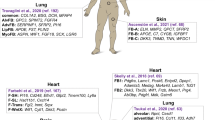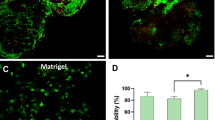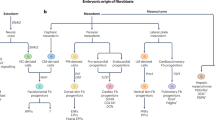Abstract
A SYSTEMATIC investigation into the method of elaboration of intercellular material in connective and skeletal tissues has shown that cytoplasmic granules, which contain polysaccharide protein components, are present in fibrogenic cells of the fowl embryo both in vivo and in vitro.
This is a preview of subscription content, access via your institution
Access options
Subscribe to this journal
Receive 51 print issues and online access
$199.00 per year
only $3.90 per issue
Buy this article
- Purchase on SpringerLink
- Instant access to full article PDF
Prices may be subject to local taxes which are calculated during checkout
Similar content being viewed by others
References
Fell, H. B., J. Anat., 46, 11 (1932). Bast, T. H., Amer. J. Anat., 29, 139 (1921).
Fitton Jackson, S., Int. Conf. of Electron Microscopy, London (1954).
Hale, C. W., Nature, 157, 802 (1946).
Gersh, I., and Catchpole, H. R., Amer. J. Anat., 85, 457 (1949).
Heller-Steinberg, M., Amer. J. Anat., 89, 347 (1951).
Jacobson, W., and Webb, M., Exp. Cell Research, 3, 163 (1952).
Author information
Authors and Affiliations
Rights and permissions
About this article
Cite this article
JACKSON, S. Cytoplasmic Granules in Fibrogenic Cells. Nature 175, 39–40 (1955). https://doi.org/10.1038/175039b0
Issue date:
DOI: https://doi.org/10.1038/175039b0
This article is cited by
-
�ber Mucopolysaccharide in der normalen Aorta und im Aortentransplantat des Hundes
Virchows Archiv f�r Pathologische Anatomie und Physiologie und f�r Klinische Medizin (1962)
-
Elektronenoptische Untersuchungen an der Gelenkkapsel und ihre Bedeutung f�r die morphologische-funktionelle Einheit des Gelenkes
Archiv f�r Orthop�dische und Unfall-Chirurgie (1962)
-
Biochemie der Wundheilung
Langenbecks Archiv für Klinische Chirurgie (1962)
-
Elektronenoptische Untersuchungen �ber die periostale Osteogenese
Zeitschrift f�r Zellforschung und Mikroskopische Anatomie (1958)
-
Aspects divers de l'ergastoplasme dans certains types cellulaires du granulome silicotique experimental
Zeitschrift f�r Zellforschung und Mikroskopische Anatomie (1957)



